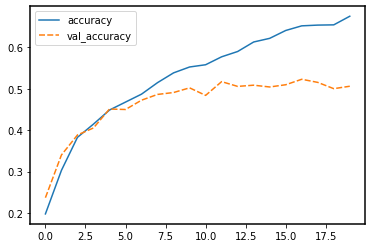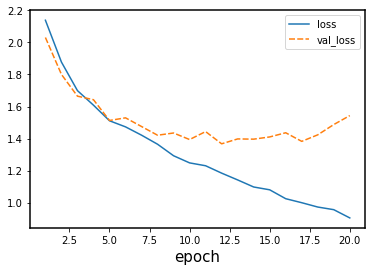Networks are like onions
Overview
Teaching: 30 min
Exercises: 45 minQuestions
Why do we need different types of layers?
What are good network designs for image data?
What is a convolutional layer?
How can we avoid overfitting?
Objectives
Understand why convolutional and pooling layers are useful for image data
Use normalization as preparation step for Deep Learning
Implement a convolutional neural network on an image dataset
Plot and interpret the training process
Do a visual inspection of the results of your neural network
Understand strategies to improve your model based on the plots
Use drop-out layer to prevent overfitting
Different types of layers
‘Networks are like onions’: a typical neural network consists of many layers. In fact, the word deep in Deep Learning refers to the many layers that make the network deep.
So far, we have seen one type of layer, namely the fully connected, or dense layer. This layer is called fully connected, because all input neurons are taken into account by each output neuron. The number of parameters that need to be learned by the network, is thus in the order of magnitude of the number of input neurons times the number of hidden neurons.
However, there are many different types of layers that perform different calculations and take different inputs. In this episode we will take a look at convolutional layers and dropout layers, which are useful in the context of image data, but also in many other types of (structured) data.
Image classification
Keras comes with a few prepared datasets. We have a look at the CIFAR10 dataset, which is a widely known dataset for image classification.
from tensorflow import keras
(train_images, train_labels), (test_images, test_labels) = keras.datasets.cifar10.load_data()
CIFAR-10
The CIFAR-10 dataset consists of images of 10 different classes: airplanes, cars, birds, cats, deer, dogs, frogs, horses, ships, and trucks. It is widely used as a benchmark dataset for image classification. The low resolution of the images in the dataset allows for quick loading and testing models.
We take a small sample of the data as training set for demonstration purposes.
n = 5000
train_images = train_images[:n]
train_labels = train_labels[:n]
Explore the data
Familiarize yourself with the CIFAR10 dataset. To start, consider the following questions:
- What is the dimension of a single data point? What do you think the dimensions mean?
- What is the range of values that your input data takes?
- What is the shape of the labels, and how many labels do we have?
Solution
To explore the dimensions of the input data:
train_images.shape(5000, 32, 32, 3)The first value,
5000, is the number of training images that we have selected. The remainder of the shape, namely32, 32, 3), denotes the dimension of one image. The last value 3 is typical for color images, and stands for the three color channels Red, Green, Blue. We are left with32, 32. This denotes the width and height of our input image in number of pixels. By convention, the first entry refers to the height, the second to the width of the image. In this case, we observe a quadratic image where height equals width.We can find out the range of values of our input data as follows:
train_images.min(), train_images.max()(0, 255)So the values of the three channels range between
0and255.Lastly, we inspect the dimension of the labels:
train_labels.shape(5000, 1)So we have, for each image, a single value denoting the label. To find out what the possible values of these labels are:
train_labels.min(), train_labels.max()(0, 9)The values of the labels range between
0and9, denoting 10 different classes.
The training set consists of 50000 images of 32x32 pixels and 3 channels (RGB values). The RGB values are between 0 and 255. For input of neural networks, it is better to have small input values. So we normalize our data between 0 and 1:
train_images = train_images / 255.0
test_images = test_images / 255.0
The labels are single numbers denoting the class. We map the class numbers back to the class names, taken from the documentation:
class_names = ['airplane', 'automobile', 'bird', 'cat', 'deer',
'dog', 'frog', 'horse', 'ship', 'truck']
Now we can plot a sample of the training images, using the plt.imshow function.
import matplotlib.pyplot as plt
plt.figure(figsize=(10,10))
for i in range(25):
plt.subplot(5,5,i+1)
plt.imshow(train_images[i], cmap=plt.cm.binary)
plt.axis('off')
plt.title(class_names[train_labels[i,0]])
plt.show()
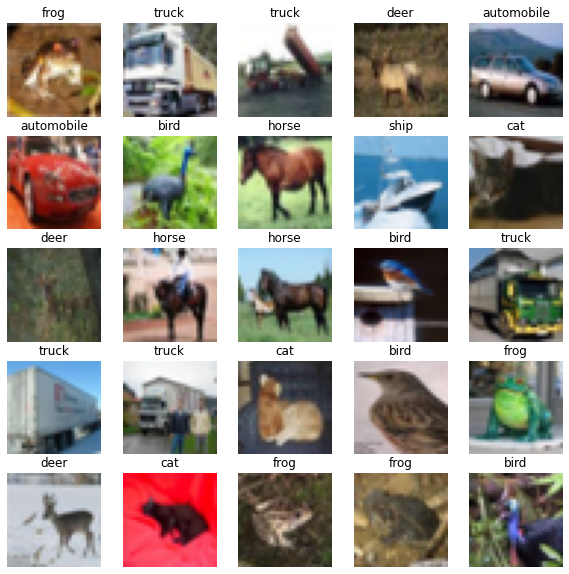
Convolutional layers
In the previous episodes, we used ‘fully connected layers’ , that connected all input values of a layer to all outputs of a layer. This results in many connections, and thus weights to be learned, in the network. Note that our input dimension is now quite high (even with small pictures of 32x32 pixels), we have:
dim = train_images.shape[1] * train_images.shape[2] * train_images.shape[3]
print(dim)
3072
Number of parameters
Suppose we create a single Dense (fully connected) layer with 100 hidden units that connect to the input pixels, how many parameters does this layer have?
Solution
Each entry of the input dimensions, i.e. the
shapeof one signal data point, is connected with 100 neurons of our hidden layer, and each of these neurons has a bias term associated to it. So we have307300parameters to learn.width, height = (32, 32) n_hidden_neurons = 100 n_bias = 100 n_input_items = width * height * 3 n_parameters = (n_input_items * n_hidden_neurons) + n_bias n_parameters307300We can also check this by building the layer in Keras:
inputs = keras.Input(shape=dim) outputs = keras.layers.Dense(100)(inputs) model = keras.models.Model(inputs=inputs, outputs=outputs) model.summary()Model: "model" _________________________________________________________________ Layer (type) Output Shape Param # ================================================================= input_1 (InputLayer) [(None, 3072)] 0 _________________________________________________________________ dense (Dense) (None, 100) 307300 ================================================================= Total params: 307,300 Trainable params: 307,300 Non-trainable params: 0 _________________________________________________________________
We can decrease the number of units in our hidden layer, but this also decreases the number of patterns our network can remember. Moreover, if we increase the image size, the number of weights will ‘explode’, even though the task of recognizing large images is not necessarily more difficult than the task of recognizing small images.
The solution is that we make the network learn in a ‘smart’ way. The features that we learn should be similar both for small and large images, and similar features (e.g. edges, corners) can appear anywhere in the image (in mathematical terms: translation invariant). We do this by making use of a concepts from image processing that precede Deep Learning.
A convolution matrix, or kernel, is a matrix transformation that we ‘slide’ over the image to calculate features at each position of the image. For each pixel, we calculate the matrix product between the kernel and the pixel with its surroundings. A kernel is typically small, between 3x3 and 7x7 pixels. We can for example think of the 3x3 kernel:
[[-1, -1, -1],
[0, 0, 0]
[1, 1, 1]]
This kernel will give a high value to a pixel if it’s on a horizontal border between dark and light areas. Note that for RGB images, the kernel should also have a depth of 3.
In the following image, we see the effect of such a kernel on the values of a single-channel image. The red cell in the output matrix is the result of multiplying and summing the values of the red square in the input, and the kernel. Applying this kernel to a real image shows that it indeed detects horizontal edges.


In our convolutional layer our hidden units are a number of convolutional matrices (or kernels), where the values of the matrices are the weights that we learn in the training process. The output of a convolutional layer is an ‘image’ for each of the kernels, that gives the output of the kernel applied to each pixel.
Border pixels
What, do you think, happens to the border pixels when applying a convolution?
Solution
There are different ways of dealing with border pixels. You can ignore them, which means that your output image is slightly smaller then your input. It is also possible to ‘pad’ the borders, e.g. with the same value or with zeros, so that the convolution can also be applied to the border pixels. In that case, the output image will have the same size as the input image.
Number of model parameters
Suppose we apply a convolutional layer with 100 kernels of size 3 * 3 * 3 (the last dimension applies to the rgb channels) to our images of 32 * 32 * 3 pixels. How many parameters do we have? Assume, for simplicity, that the kernels do not use bias terms. Compare this to the answer of the previous exercise
Solution
We have 100 matrices with 3 * 3 * 3 = 27 values each so that gives 27 * 100 = 2700 weights. This is a magnitude of 100 less than the fully connected layer with 100 units! Nevertheless, as we will see, convolutional networks work very well for image data. This illustrates the expressiveness of convolutional layers.
So let’s look at a network with a few convolutional layers. We need to finish with a Dense layer to connect the output cells of the convolutional layer to the outputs for our classes.
inputs = keras.Input(shape=train_images.shape[1:])
x = keras.layers.Conv2D(32, (3, 3), activation='relu')(inputs)
x = keras.layers.Conv2D(32, (3, 3), activation='relu')(x)
x = keras.layers.Flatten()(x)
outputs = keras.layers.Dense(10)(x)
model = keras.Model(inputs=inputs, outputs=outputs, name="cifar_model_small")
model.summary()
Convolutional Neural Network
Inspect the network above:
- What do you think is the function of the
Flattenlayer?- Which layer has the most parameters? Do you find this intuitive?
Solution
- The Flatten layer converts the 28x28x32 output of the convolutional layer into a single one-dimensional vector, that can be used as input for a dense layer.
- The last dense layer has the most parameters. This layer connects every single output ‘pixel’ from the convolutional layer to the 10 output classes. That results in a large number of connections, so a large number of parameters. This undermines a bit the expressiveness of the convolutional layers, that have much fewer parameters.
Often in convolutional neural networks, the convolutional layers are intertwined with Pooling layers. As opposed to the convolutional layer, the pooling layer actually alters the dimensions of the image and reduces it by a scaling factor. It is basically decreasing the resolution of your picture. The rationale behind this is that higher layers of the network should focus on higher-level features of the image. By introducing a pooling layer, the subsequent convolutional layer has a broader ‘view’ on the original image.
Let’s put it into practice. We compose a Convolutional network with two convolutional layers and two pooling layers.
inputs = keras.Input(shape=train_images.shape[1:])
x = keras.layers.Conv2D(32, (3, 3), activation='relu')(inputs)
x = keras.layers.MaxPooling2D((2, 2))(x)
x = keras.layers.Conv2D(32, (3, 3), activation='relu')(x)
x = keras.layers.MaxPooling2D((2, 2))(x)
x = keras.layers.Flatten()(x)
x = keras.layers.Dense(32, activation='relu')(x)
outputs = keras.layers.Dense(10)(x)
model = keras.Model(inputs=inputs, outputs=outputs, name="cifar_model_small")
model.summary()
Model: "cifar_model_small"
_________________________________________________________________
Layer (type) Output Shape Param #
=================================================================
input_6 (InputLayer) [(None, 32, 32, 3)] 0
_________________________________________________________________
conv2d_3 (Conv2D) (None, 30, 30, 32) 896
_________________________________________________________________
max_pooling2d (MaxPooling2D) (None, 15, 15, 32) 0
_________________________________________________________________
conv2d_4 (Conv2D) (None, 13, 13, 32) 9248
_________________________________________________________________
max_pooling2d_1 (MaxPooling2 (None, 6, 6, 32) 0
_________________________________________________________________
flatten (Flatten) (None, 1152) 0
_________________________________________________________________
dense_1 (Dense) (None, 32) 36896
_________________________________________________________________
dense_2 (Dense) (None, 10) 330
=================================================================
Total params: 47,370
Trainable params: 47,370
Non-trainable params: 0
_________________________________________________________________
We compile the model and train it on our training data for 10 epochs
model.compile(optimizer='adam',
loss=keras.losses.SparseCategoricalCrossentropy(from_logits=True),
metrics=['accuracy'])
history = model.fit(train_images, train_labels, epochs=10,
validation_data=(test_images, test_labels))
We can plot the training process using the history:
import seaborn as sns
import pandas as pd
history_df = pd.DataFrame.from_dict(history.history)
sns.lineplot(data=history_df[['accuracy', 'val_accuracy']])

sns.lineplot(data=history_df[['loss', 'val_loss']])
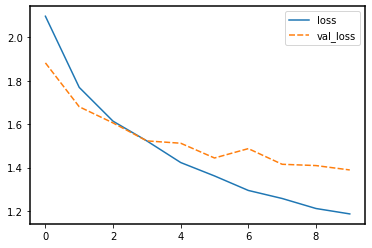
It seems that the model is overfitting somewhat, because the validation accuracy and loss stagnates.
Network depth
What, do you think, will be the effect of adding a convolutional layer to your model? Will this model have more or fewer parameters? Try it out. Create a
modelthat has an additionalConv2dlayer with 32 filters after the last MaxPooling2D layer. Train it for 20 epochs and plot the results.HINT: The model definition that we used previously needs to be adjusted as follows:
inputs = keras.Input(shape=train_images.shape[1:]) x = keras.layers.Conv2D(32, (3, 3), activation='relu')(inputs) x = keras.layers.MaxPooling2D((2, 2))(x) x = keras.layers.Conv2D(32, (3, 3), activation='relu')(x) x = keras.layers.MaxPooling2D((2, 2))(x) # Add your extra layer here x = keras.layers.Flatten()(x) x = keras.layers.Dense(32, activation='relu')(x) outputs = keras.layers.Dense(10)(x)Solution
We add a an extra Conv2D layer after the second pooling layer:
inputs = keras.Input(shape=train_images.shape[1:]) x = keras.layers.Conv2D(32, (3, 3), activation='relu')(inputs) x = keras.layers.MaxPooling2D((2, 2))(x) x = keras.layers.Conv2D(32, (3, 3), activation='relu')(x) x = keras.layers.MaxPooling2D((2, 2))(x) x = keras.layers.Conv2D(32, (3, 3), activation='relu')(x) x = keras.layers.Flatten()(x) x = keras.layers.Dense(32, activation='relu')(x) outputs = keras.layers.Dense(10)(x) model = keras.Model(inputs=inputs, outputs=outputs, name="cifar_model")With the model defined above, we can inspect the number of parameters:
model.summary()Model: "cifar_model" _________________________________________________________________ Layer (type) Output Shape Param # ================================================================= input_4 (InputLayer) [(None, 32, 32, 3)] 0 _________________________________________________________________ conv2d_6 (Conv2D) (None, 30, 30, 32) 896 _________________________________________________________________ max_pooling2d_4 (MaxPooling2 (None, 15, 15, 32) 0 _________________________________________________________________ conv2d_7 (Conv2D) (None, 13, 13, 32) 9248 _________________________________________________________________ max_pooling2d_5 (MaxPooling2 (None, 6, 6, 32) 0 _________________________________________________________________ conv2d_8 (Conv2D) (None, 4, 4, 32) 9248 _________________________________________________________________ flatten_3 (Flatten) (None, 512) 0 _________________________________________________________________ dense_6 (Dense) (None, 32) 16416 _________________________________________________________________ dense_7 (Dense) (None, 10) 330 ================================================================= Total params: 36,138 Trainable params: 36,138 Non-trainable params: 0 _________________________________________________________________The number of parameters has decreased by adding this layer. We can see that the conv layer decreases the resolution from 6x6 to 4x4, as a result, the input of the Dense layer is smaller than in the previous network.
To train the network and plot the results:
model.compile(optimizer='adam', loss=keras.losses.SparseCategoricalCrossentropy(from_logits=True), metrics=['accuracy']) history = model.fit(train_images, train_labels, epochs=20, validation_data=(test_images, test_labels)) history_df = pd.DataFrame.from_dict(history.history) sns.lineplot(data=history_df[['accuracy', 'val_accuracy']])
sns.lineplot(data=history_df[['loss', 'val_loss']])
Other types of data
Convolutional and Pooling layers are also applicable to different types of data than image data. Whenever the data is ordered in a (spatial) dimension, and translation invariant features are expected to be useful, convolutions can be used. Think for example of time series data from an accelerometer, audio data for speech recognition, or 3d structures of chemical compounds.
Dropout
Note that the training loss continues to decrease, while the validation loss stagnates, and even starts to increase over the course of the epochs. Similarly, the accuracy for the validation set does not improve anymore after some epochs. This means we are overfitting on our training data set.
Techniques to avoid overfitting, or to improve model generalization, are termed regularization techniques.
One of the most versatile regularization technique is dropout (Srivastava et al., 2014).
Dropout essentially means that during each training cycle a random fraction of the dense layer nodes are turned off. This is described with the dropout rate between 0 and 1 which determines the fraction of nodes to silence at a time.
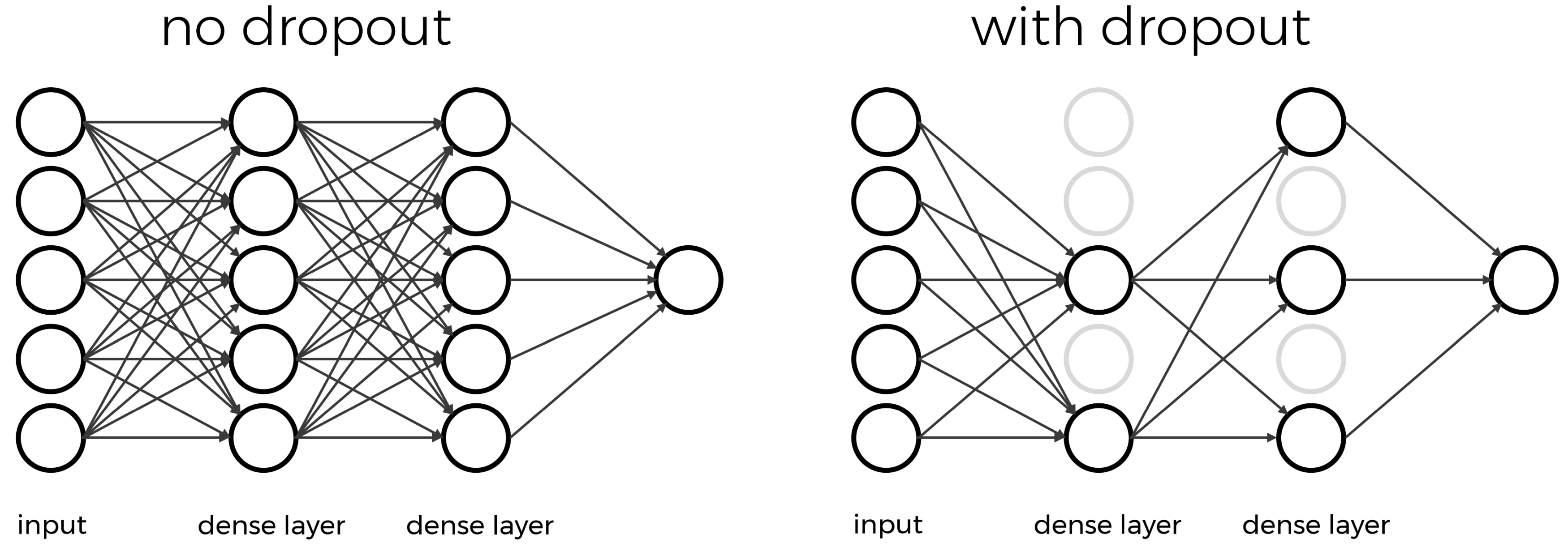 The intuition behind dropout is that it enforces redundancies in the network by constantly removing different elements of a network. The model can no longer rely on individual nodes and instead must create multiple “paths”. In addition, the model has to make predictions with much fewer nodes and weights (connections between the nodes).
As a result, it becomes much harder for a network to memorize particular features. At first this might appear a quiet drastic approach which affects the network architecture strongly.
In practice, however, dropout is computationally a very elegant solution which does not affect training speed. And it frequently works very well.
The intuition behind dropout is that it enforces redundancies in the network by constantly removing different elements of a network. The model can no longer rely on individual nodes and instead must create multiple “paths”. In addition, the model has to make predictions with much fewer nodes and weights (connections between the nodes).
As a result, it becomes much harder for a network to memorize particular features. At first this might appear a quiet drastic approach which affects the network architecture strongly.
In practice, however, dropout is computationally a very elegant solution which does not affect training speed. And it frequently works very well.
Important to note: Dropout layers will only randomly silence nodes during training! During a predictions step, all nodes remain active (dropout is off). During training, the sample of nodes that are silenced are different for each training instance, to give all nodes a chance to observe enough training data to learn its weights.
Let’s add one dropout layer towards the end of the network, that randomly drops 20% of the input units.
inputs = keras.Input(shape=train_images.shape[1:])
x = keras.layers.Conv2D(32, (3, 3), activation='relu')(inputs)
x = keras.layers.MaxPooling2D((2, 2))(x)
x = keras.layers.Conv2D(32, (3, 3), activation='relu')(x)
x = keras.layers.MaxPooling2D((2, 2))(x)
x = keras.layers.Conv2D(32, (3, 3), activation='relu')(x)
x = keras.layers.Dropout(0.2)(x) # This is new!
x = keras.layers.Flatten()(x)
x = keras.layers.Dense(32, activation='relu')(x)
outputs = keras.layers.Dense(10)(x)
model_dropout = keras.Model(inputs=inputs, outputs=outputs, name="cifar_model")
model_dropout.summary()
Model: "cifar_model"
_________________________________________________________________
Layer (type) Output Shape Param #
=================================================================
input_5 (InputLayer) [(None, 32, 32, 3)] 0
_________________________________________________________________
conv2d_9 (Conv2D) (None, 30, 30, 32) 896
_________________________________________________________________
max_pooling2d_6 (MaxPooling2 (None, 15, 15, 32) 0
_________________________________________________________________
conv2d_10 (Conv2D) (None, 13, 13, 32) 9248
_________________________________________________________________
max_pooling2d_7 (MaxPooling2 (None, 6, 6, 32) 0
_________________________________________________________________
conv2d_11 (Conv2D) (None, 4, 4, 32) 9248
_________________________________________________________________
dropout (Dropout) (None, 4, 4, 32) 0
_________________________________________________________________
flatten_4 (Flatten) (None, 512) 0
_________________________________________________________________
dense_8 (Dense) (None, 32) 16416
_________________________________________________________________
dense_9 (Dense) (None, 10) 330
=================================================================
Total params: 36,138
Trainable params: 36,138
Non-trainable params: 0
_________________________________________________________________
We can see that the dropout does note alter the dimensions of the image, and has zero parameters.
We again compile and train the model.
model_dropout.compile(optimizer='adam',
loss=keras.losses.SparseCategoricalCrossentropy(from_logits=True),
metrics=['accuracy'])
history_dropout = model_dropout.fit(train_images, train_labels, epochs=20,
validation_data=(test_images, test_labels))
And inspect the training results:
history_df = pd.DataFrame.from_dict(history_dropout.history)
history_df['epoch'] = range(1,len(history_df)+1)
history_df = history_df.set_index('epoch')
sns.lineplot(data=history_df[['accuracy', 'val_accuracy']])
test_loss, test_acc = model_dropout.evaluate(test_images, test_labels, verbose=2)
313/313 - 2s - loss: 1.4683 - accuracy: 0.5307
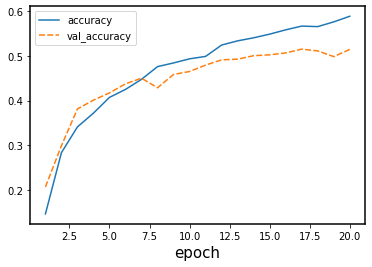
sns.lineplot(data=history_df[['loss', 'val_loss']])
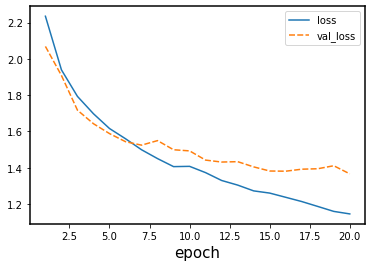
Now we see that the gap between the training accuracy and validation accuracy is much smaller, and that the final accuracy on the validation set is higher than without dropout. Nevertheless, there is still some difference between the training loss and validation loss, so we could experiment with regularization even more.
Key Points
Convolutional layers make efficient reuse of model parameters.
Pooling layers decrease the resolution of your input
Dropout is a way to prevent overfitting
